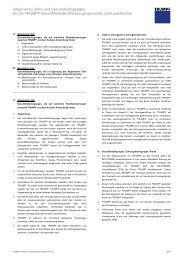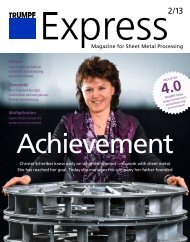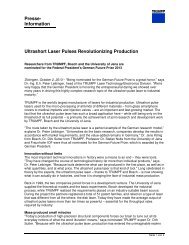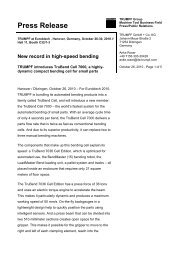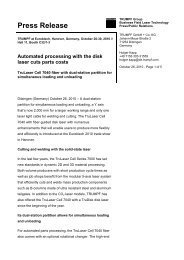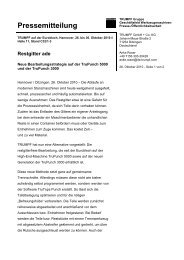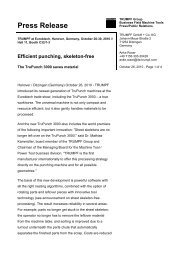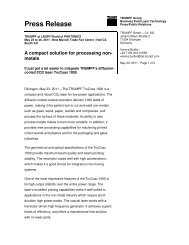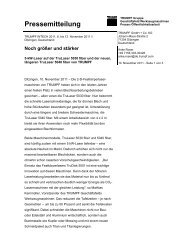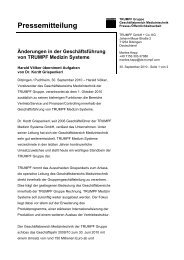Journal - Trumpf GmbH + Co. KG
Journal - Trumpf GmbH + Co. KG
Journal - Trumpf GmbH + Co. KG
You also want an ePaper? Increase the reach of your titles
YUMPU automatically turns print PDFs into web optimized ePapers that Google loves.
Technology: Punching<br />
A movable extra<br />
The new machine option<br />
“active die” is installed beneath<br />
the worktable and<br />
adjustable in height:<br />
• scratch-free sheet<br />
metal processing<br />
• an active forming<br />
stroke from below<br />
• larger area reforming<br />
with the use of new and<br />
bigger forming tools<br />
• simple programming<br />
The active die is an option<br />
that may be used with<br />
the TruPunch 5000 (starting<br />
from serial number<br />
S06.00) and the TruMatic<br />
7000 (starting from serial<br />
number S02.00).<br />
Michael Berger, technician<br />
for Punching Tools,<br />
explains what the active<br />
die makes possible.<br />
10 TruServices <strong>Journal</strong> 02|08<br />
May we have a word with you, Mr. Berger?<br />
Active die<br />
The active die promises new dimensions in forming.<br />
Is that promise justified?<br />
Michael Berger: The die mount is movable and executes an active forming<br />
stroke from below. That opens up possibilities that were hard to achieve in<br />
the past. We can set out on entirely new paths in regard to the machining<br />
strategy or tool concepts.<br />
Which new solutions can you offer?<br />
Berger: The active die enables larger and deeper forming. The fact that it<br />
can be lowered opens up more space. What’s more, we can employ entirely<br />
new tools in dimensions that were inconceivable in the past. We developed<br />
one tool, for example, with an extrusion of 60 millimeters in diameter. In<br />
other forming operations, as well, such as cups and bendings, we can capitalize<br />
on these advantages.<br />
Are there other changes in the tools?<br />
Berger: The space we gained by lowering the die makes it possible to install<br />
extras in the tool, such as more pressure springs. The extrusion tool, for<br />
example, has been fitted with a completely new packet of pressure springs<br />
and that’s the real attraction in that tool. What’s more, the extrusion distance<br />
is greater than in previous models, making forming possible at<br />
depths of up to ten millimeters. Thanks to the springs, the sheet metal<br />
remains relatively flat during forming. Existing tools can also be used on<br />
the new machines, fitted with the active die, without problems.<br />
What benefits can users expect as well?<br />
Berger: One major advantage is that the die makes scratch-free<br />
punching and forming possible without requiring accessories<br />
such as coated ejectors. The die can be lowered during<br />
processing so that it does not touch the workpiece<br />
at all. This also simplifies programming since the<br />
die no longer represents a hindrance that has to<br />
be “programmed around” when removing the<br />
part. It also makes better utilization of material<br />
possible and that saves costs.<br />
How does that work?<br />
Berger: Since the sheet metal is no longer<br />
lifted by the tool but, instead lays flat<br />
against the die, the customer can use the<br />
forming tools closer to the holding clamps.<br />
That reduces scrap and lowers material costs.<br />
>> technik.tooling@de.trumpf.com



